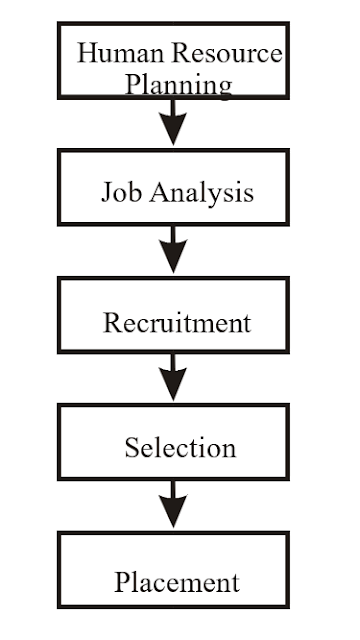Definition of Recruitment and process?
Recruitment forms a step in the process that continues with
selection and ceases with the placement of the candidate. It is the next step
in the procurement function, the first being manpower planning. Recruiting
makes it possible to acquire the number and types of people necessary to ensure
the continued operation of the organization. Recruiting is the discovery of
potential applicants for actual or anticipated organizational vacancies.
According
to Edwin B. Flippo, “Recruitment is the process of searching for
prospective employees and stimulating them to apply for jobs in the
organization.”
According
to Lord, “Recruitment is a form of competition. Just as corporations
compete to develop, manufacture, and market the best product or service, they must also compete to identify, attract and hire the most qualified people.
Recruitment is a business, and it is a big business.”
In the
words of Dale Yoder, “ Recruiting is a process to discover the sources of
manpower to meet the requirements of the staffing schedule and to employ
effective measures for attracting that
manpower in adequate numbers to facilitate effective selection of an
efficient working force.”
 |
| Recruitment to Human Resource Acquisition Process |
Figure
4.1: Recruitment to Human Resource Acquisition Process
According to
Werther and Davis, “Recruitment is the process
of finding and attracting capable applicants for employment. The process begins
when new recruits are sought and ends when their applications are submitted.
The result is a pool of applicants from which new employees are selected.”
Dales S.
Beach writes, “Recruitment is the development and maintenance of adequate
manpower resources. It involves the creation of a pool of available labor upon
whom the organization can depend when it needs additional employees.”
Thus, the recruitment process is concerned with the
identification of possible sources of human resource supply and tapping those
sources. In the total process of acquiring and placing human resources in the
organization, recruitment falls in between different sub-processes as shown in
Figure 4.2.
According to Scott, Clothier, and Spriegel the need for recruitment arises out of the following situations:
- Vacancies are created due to expansion, diversification, and growth of the business.
•
An increase in the competitive advantage of certain
concerns, enabling them to get more of the available business than formerly.
•
An increase in business arising from an upswing during
the recovery period of a business cycle.
•
Vacancies created due to transfer, promotion,
retirement, termination, permanent disability, or death.
•
The normal population growth, requires increased
goods and services to meet the needs of the people.
•
A rising standard of living, which requires more of
the same goods and services as well as the creation of new wants to be
satisfied.
Process of
Recruitment
![]()
The recruitment process passes through the following stages:
•
Recruitment process begins when the personnel
department receives requisitions for recruitment from any department of the
company, The personnel requisitions contain details about the position to be
filled, number of persons to be recruited, the duties to be performed,
qualifications expected from the candidates, terms, and conditions of employment
and the time by which the persons should be available for appointment, etc.
•
Locating and developing the sources of the required number
and type of employees.
•
Identifying the prospective employees with required
characteristics.
•
Developing the techniques to attract the desired
candidates. The goodwill of an organization in the market may be one technique.
The publicity about the company being a good employer may also help in
stimulating candidates to apply. There may be others with attractive salaries,
proper facilities for development, etc.
•
Evaluating the effectiveness of the recruitment process.
According
to Famularo, the personnel recruitment process involves five elements, viz.,
a recruitment policy, a recruitment organization, a forecast of manpower, the
development of sources of recruitment, different techniques used for
utilizing these sources, and a method of assessing the recruitment program.
The explanation of these is described below:
1. Recruitment Policy: It
specifies the objectives of recruitment and provides a framework for the
implementation of the recruitment program. It also involves the employer’s
commitment to some principles as to finding and employing the best-qualified persons
for each job, retaining the most promising of those hired, etc. It should be
based on the goals, needs, and environment of the organization.
Figure 4.2: Place of Recruitment in the Selection System
2.
Recruitment
Organisation: The recruitment may be centralized like public sector banks
or decentralized. Both practices have their own merits. The choice between the
two will depend on the managerial philosophy and the particular needs of the
organization.
3.
Sources of
Recruitment: Various sources of recruitment may be classified as
internal and external. These have their own merits and demerits.
4.
Methods of
Recruitment: Recruitment techniques are the means to make contact with
potential candidates, provide the necessary information, and encourage
them to apply for jobs.
5.
Evaluation
of Recruitment Programme: The recruitment process must be evaluated
periodically. The criteria for evaluation may consist of cost per applicant,
the hiring ratio, performance appraisal, tenure of stay, etc. After evaluation,
necessary improvements should be made to the recruitment program.


